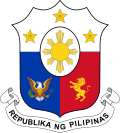| Presidential Medal of Merit | |
|---|---|
| Ribbon of the medal | |
| Type | Medal |
| Awarded for | See Award |
| Presented by | |
| Status | Currently constituted |
| Precedence | |
| Next (higher) | Order of the Golden Heart |
| Next (lower) | Order of Lapu-Lapu and Order of the Knights of Rizal |
The Presidential Medal of Merit (Pampanguluhang Medalya ng Merito) is an honor given by the Republic of the Philippines.
